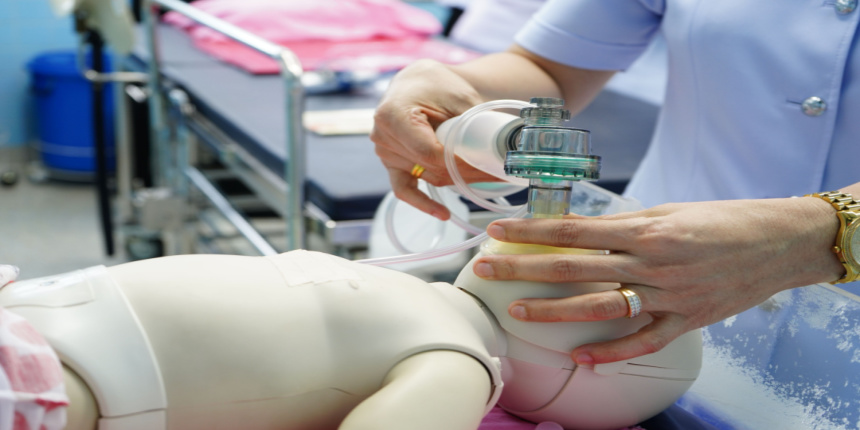NRP Full Form
What is the full form of NRP?
The full form of NRP is Neonatal Resuscitation Program. This software was initiated by the AAP to address infants' basic resuscitation abilities.
The Neonatal Resuscitation Program (NRP) training teaches an evidence-based method for caring for the infant at birth and supports efficient team-based treatment for healthcare professionals who attend to newborns at the moment of delivery. With a mixed learning strategy, NRP emphasises the development of key leadership, communication, and teamwork abilities through both hands-on case-based simulation and debriefing and online assessment.
- History of NRP
- Roles of NRP in India
- Achievements
- Summary of NRP

History of NRP
The Neonatal Resuscitation Program (NRP) was created in 1987 in response to the growing demand for an educational programme that concentrated on the early care of neonates who needed to be transferred to the NICU.
Newborn intensive care units (NICUs) were becoming more and more prevalent by the middle of the 1970s, and as a result, the National Institutes of Health (NIH) supported five studies to give hospitals with level 1 perinatal services basic instruction on neonatal care. The 6-module Neonatal Education Program (NEP), which focuses on neonatal resuscitation, was created by Dr. Ron Bloom and Cathy Cropley. The Neonatal Resuscitation Program was built on the foundation of these modules.
Roles of NRP in India
Under the direction of the National Neonatology Forum, well-designed training programmes have been running in various parts of India since 1990. (NNF).
Their main objective has been to give neonatal care providers and other medical professionals with training in neonatal resuscitation and to make sure they have access to the required supplies.
NRP was also increasingly incorporated into the curricula of several medical and nursing institutes and universities.
Additionally, those who complete the NNF programme go on to educate other healthcare professionals across the nation in the NRP.
So there has been a noticeable decrease in foetal anoxia and associated medical issues as a result of their joint efforts.
Achievements
In 130 countries, NRP continues to provide award-winning, cutting-edge interactive education that meets the demands of teachers and other providers.
By March 2022, more than 5 million healthcare professionals would have received new training or updated training.
Approximately 18,500 instructors are engaged at this time in the NRP. The NRP Provider Course is completed by about 200,000 students annually.
Summary of NRP
In comparison to previous approaches, the Neonatal Resuscitation Program is a significantly more effective method. The successful use of programming expertise is crucial to the survival of newborn infants. Because of this, the American Association of Pediatrics (AAP) has given the program's creation and implementation careful consideration throughout the past few decades.
The NRP has seen several changes and improvements since it first started, and these changes together have an impact on the final result. The current programme is made up of simple-to-implement procedures that are extremely effective and guarantee the health of parents and infants. The program's structural evolution also grew to incorporate new cutting-edge techniques.
Frequently Asked Questions (FAQs)
The neonatal resuscitation programme (NRP) is intended for people who assist with neonatal resuscitation in the delivery room and newborn nursery. The NRP courses are given as a service to community hospitals by the Regional Outreach Education Program or are presented in community hospitals by NRP Instructors.
The Neonatal Resuscitation Program Steering Committee (NRPSC) plans, creates, and puts into action educational initiatives that advance the best possible newborn care and resuscitation techniques. The NRPSC wants to see all newborns who require resuscitation treated skillfully by medical personnel. The NRPSC creates and improves evidence-based practice guidelines and instructional materials in support of this aim. The Committee on Foetus and Newborn (COFN), Section on Perinatal Pediatrics, Section on Hospital Medicine, American College of Obstetricians and Gynecologists (ACOG), and Canadian Pediatric Society are among the essential stakeholders with which the NRPSC works in conjunction (CPS).
The American Academy of Pediatrics is dedicated to enhancing newborn outcomes all across the globe. We developed "Helping Babies Survive" in collaboration with the World Health Organization (WHO), the US Agency for International Development, Saving Newborn Lives, the National Institute of Child Health and Human Development (NICHD), and a number of other international health organisations. The participants of this ground-breaking programme will learn how to revive neonates in nations with scarce resources.
Performance Skills Stations (optional), Integrated Skills Station (mandatory), and Simulation and Debriefing are all components of the in person NRP Provider course (required). At a Provider course, the approved NRP instructor to learner ratio is one instructor to 34 students.
The Neonatal Resuscitation Program suggests limiting intubation efforts to 20 seconds. Junior doctors regularly fail to intubate infants, and many are intubated for 20 to 30 seconds with no obvious detrimental consequence.

